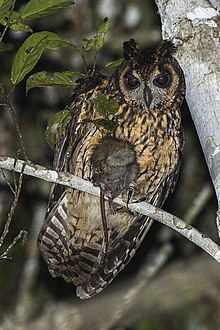Madagascar owl
| Madagascar owl | |
|---|---|

| |
| Scientific classification | |
| Domain: | Eukaryota |
| Kingdom: | Animalia |
| Phylum: | Chordata |
| Class: | Aves |
| Order: | Strigiformes |
| Family: | Strigidae |
| Genus: | Asio |
| Species: | A. madagascariensis
|
| Binomial name | |
| Asio madagascariensis (A. Smith, 1834)
| |
The Madagascar owl (Asio madagascariensis), also known as the Madagascan owl or Madagascar long-eared owl,
Description
The Madagascar owl is similar in appearance to the
Its call is usually a series of barks, varying in pitch and volume, but sometimes it will utter a series of more hoot-like notes, described by some as ulooh.[3]
Distribution and habitat
The Madagascar owl is endemic to Madagascar, where it is widespread in the west and centre of the island.[6] It is generally found at elevations ranging from sea level to 1,600 m (5,200 ft),[3] though it occasionally ranges as high as 1,800 m (5,900 ft).[7] It inhabits a variety of woodland habitats, mainly in the drier western forests, although it appears quite adaptable, and also occurs in degraded habitats, even on the central plateau where the forest cover has been fragmented.[6]
Behaviour
Like most owls, the Madagascar owl is
Little is known about its breeding biology.[7] It is thought to lay its eggs in stick nests created by other animals, like the closely related long-eared owl.[6]
References
- ^ . Retrieved 13 November 2021.
- ^ "Appendices | CITES". cites.org. Retrieved 2022-01-14.
- ^ ISBN 1-873403-45-3.
- ISBN 0-300-04969-2.
- ISBN 1-85974-100-2.
- ^ a b c "Madagascar Owl (Asio madagascariensis)". Planet of Birds. Retrieved 26 October 2016.
- ^ ISBN 1-55297-845-1.
- ^ Goodman, Steven M.; Creighton, G. Ken; Raxworthy, Christopher (1991). "The Food Habits of the Madagascar Long-Eared Owl in south-eastern Madagascar". Bonner zoologische Beiträge. 42 (1): 21–26.

